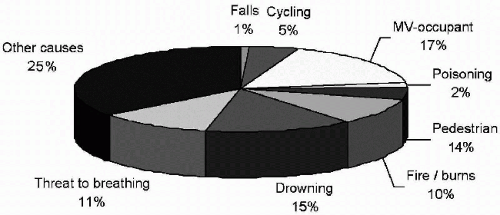Injury Prevention
Safe Kids Canada
EPIDEMIOLOGY
In Canada, the leading cause of death for children is unintentional injury (Figs. 20-1 and 20-2).
Falls
Babies fall off beds or out of cribs while playing, sleeping, or trying to get out of them.
Adult beds are involved in one-third of cases where a baby fell off a bed.1
Infant falls often result in head and neck injuries.2
Head injuries for infants can have lifelong implications on brain development.1
Falls involving stairs and steps:
63% of children injured were under age 5.
23% were ages 5 to 9.
14% were ages 10 to 14.3
Playground falls:
14% of children are hospitalized for head injuries.
81% for broken bones to other parts of the body.
5% for injuries such as dislocations and open wounds.3
Motor Vehicle Crashes
The leading cause of injury-related death for Canadian children (Table 20-1).
Can cause multiple serious injuries, such as spine and internal organ damage.
Drowning
Babies under age 1 are most likely to drown in the bathtub.6
Toddlers ages 1 to 4 are most likely to drown* in home swimming pools followed by, large bodies of water such as rivers, ponds, and beach areas.6
Most toddler drownings occur when the child is walking or playing near water, not intending to swim, and often without an adult knowing the child is near the water.6
In a 10-year review, the Canadian Red Cross found that 42% of drowning victims, ages 5 to 14, did not have adult supervision at the time.6
Burns
56% of hospitalizations for burns are caused by scald burns.
Children under the age of 5 suffer 83% of all scald hospital admissions.3
Poisoning
64% of poisoning occurs in children ages 1 to 4.3
Medication, both over-the-counter and prescription, is involved in 67% of all unintentional poisoning of children age 14 and under.3
Other causes include household cleaners, alcohol, plants, fertilizers, pesticides, paint thinner, and antifreeze.3
TABLE 20-1 Annual Risk of Death and Injury for Canadian Children Under the Age of 14 | |||||||||||||||||||||||||||||||||||||||||||||||||||||||
|---|---|---|---|---|---|---|---|---|---|---|---|---|---|---|---|---|---|---|---|---|---|---|---|---|---|---|---|---|---|---|---|---|---|---|---|---|---|---|---|---|---|---|---|---|---|---|---|---|---|---|---|---|---|---|---|
| |||||||||||||||||||||||||||||||||||||||||||||||||||||||
Pedestrian
Choking, Strangulation, and Suffocation
80% of children treated for threats to breathing were under age 5.3
Hospitalizations:
 FIGURE 20-1 • Major causes of unintentional injury deaths among Canadian children aged 0 to 14 years, 1994 to 2003. (Note: Death trends for 2003 were estimated from trends for the years 1994 to 2002. “Other causes” refers to types of injury such as sports-related deaths, firearms, or machinery. The death data are gathered in such a way that they often capture whether a child was struck by and struck against something, rather than the activity that the child was involved in at the time of injury. (From Statistics Canada, as used in Safe Kids Canada. Child & Youth Unintentional Injury: 10 Years In Review, 1994-2003. Toronto: Safe Kids Canada; 2006.)

Full access? Get Clinical Tree
 Get Clinical Tree app for offline access
Get Clinical Tree app for offline access

|





